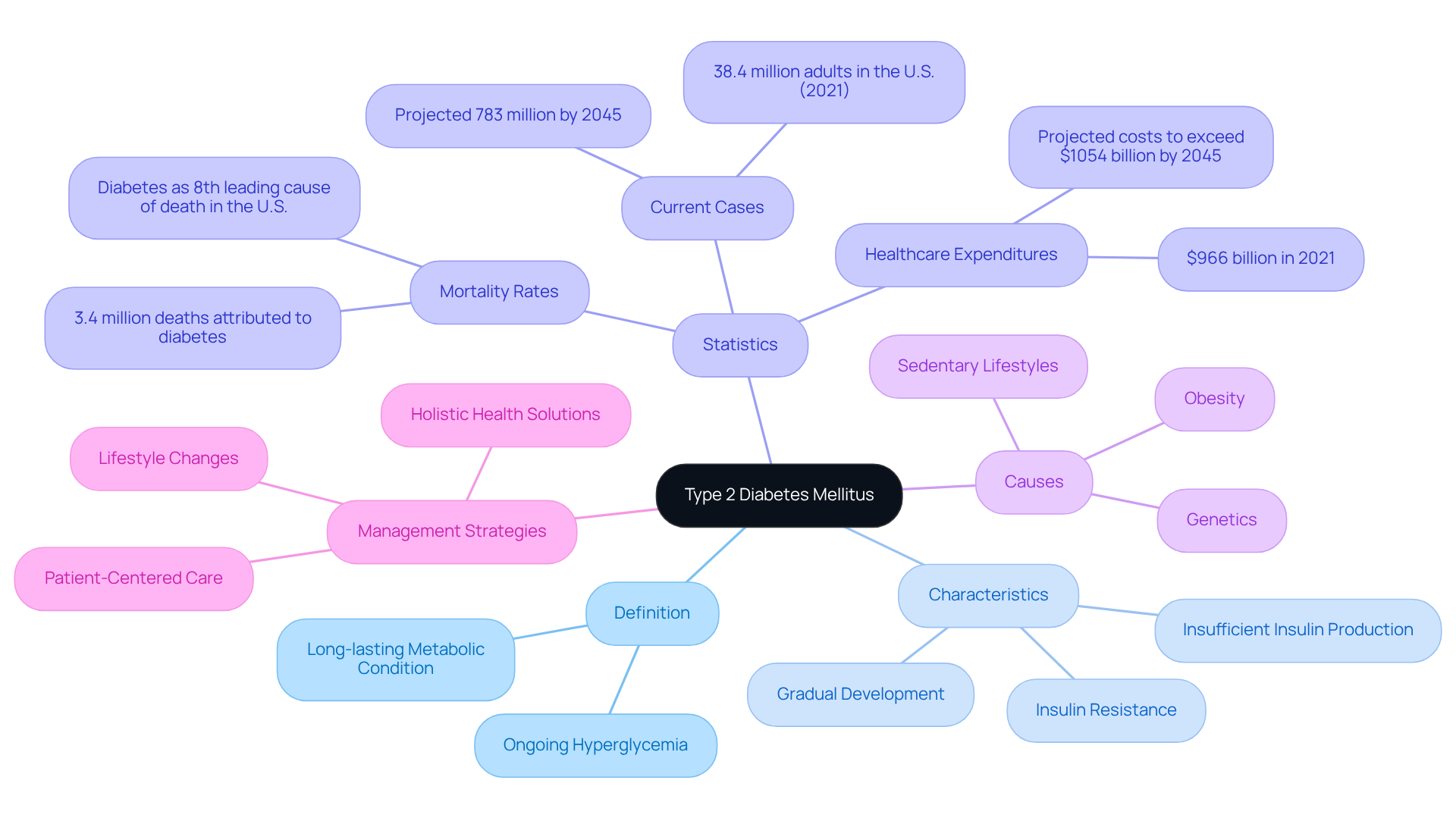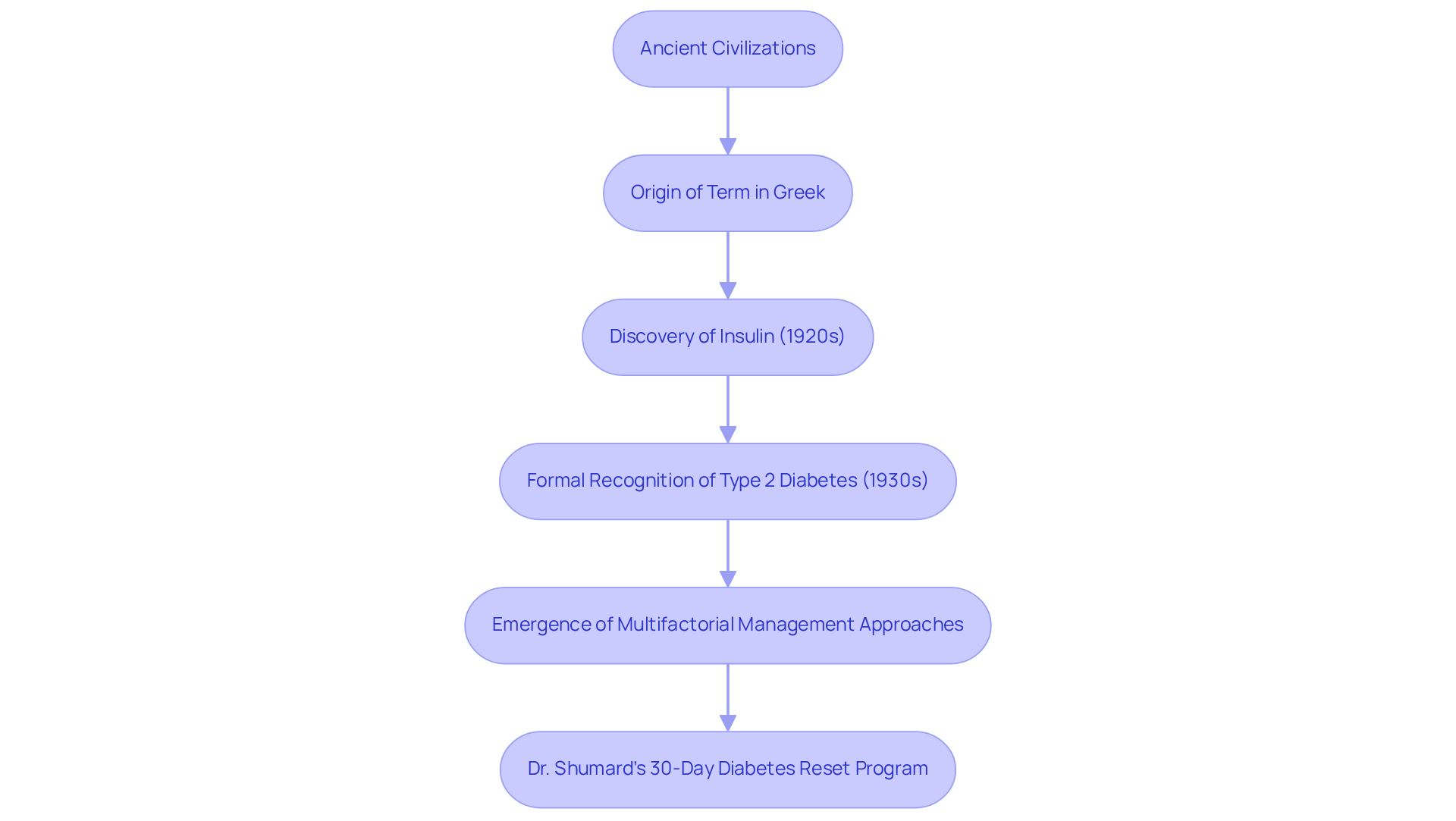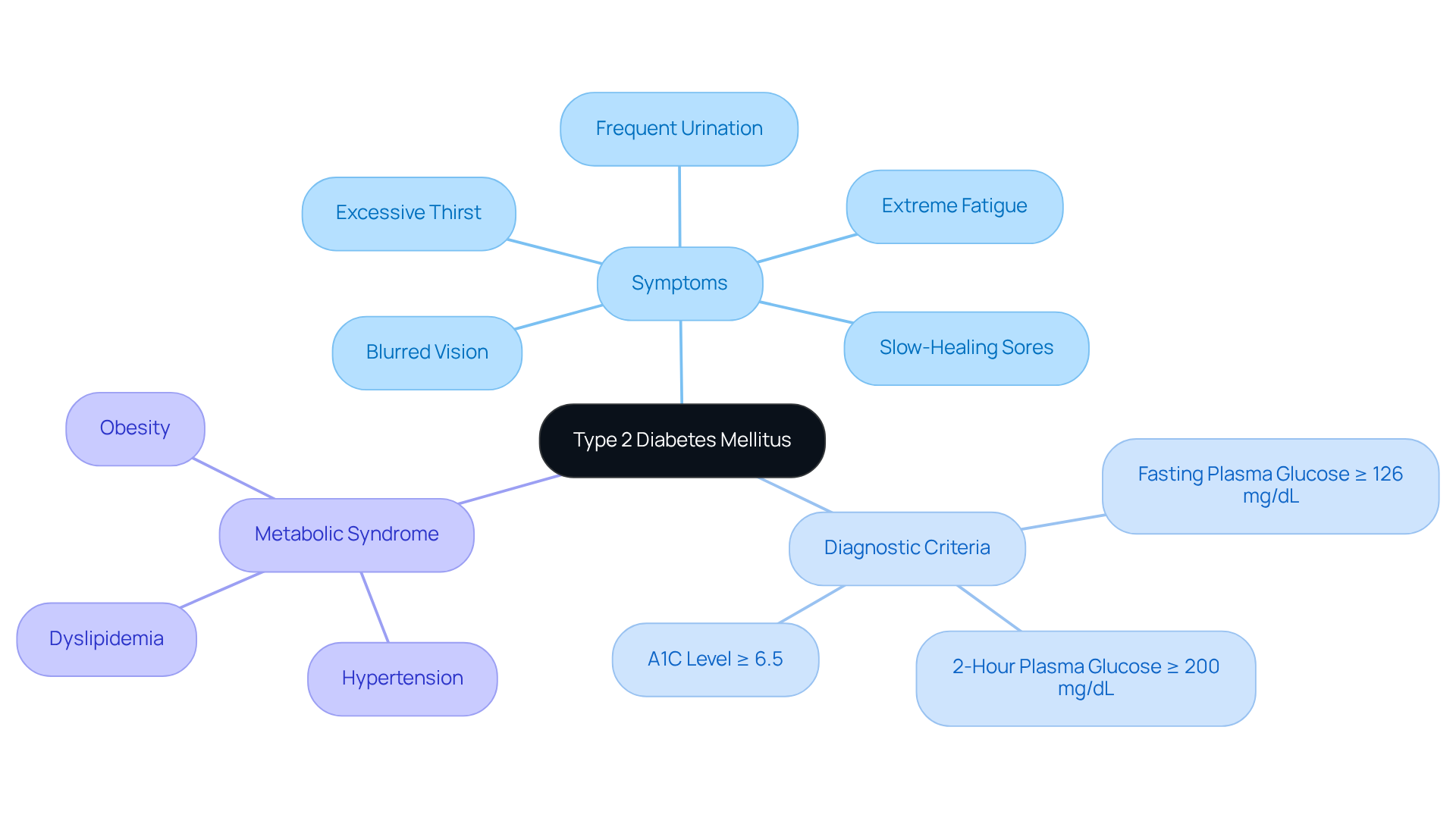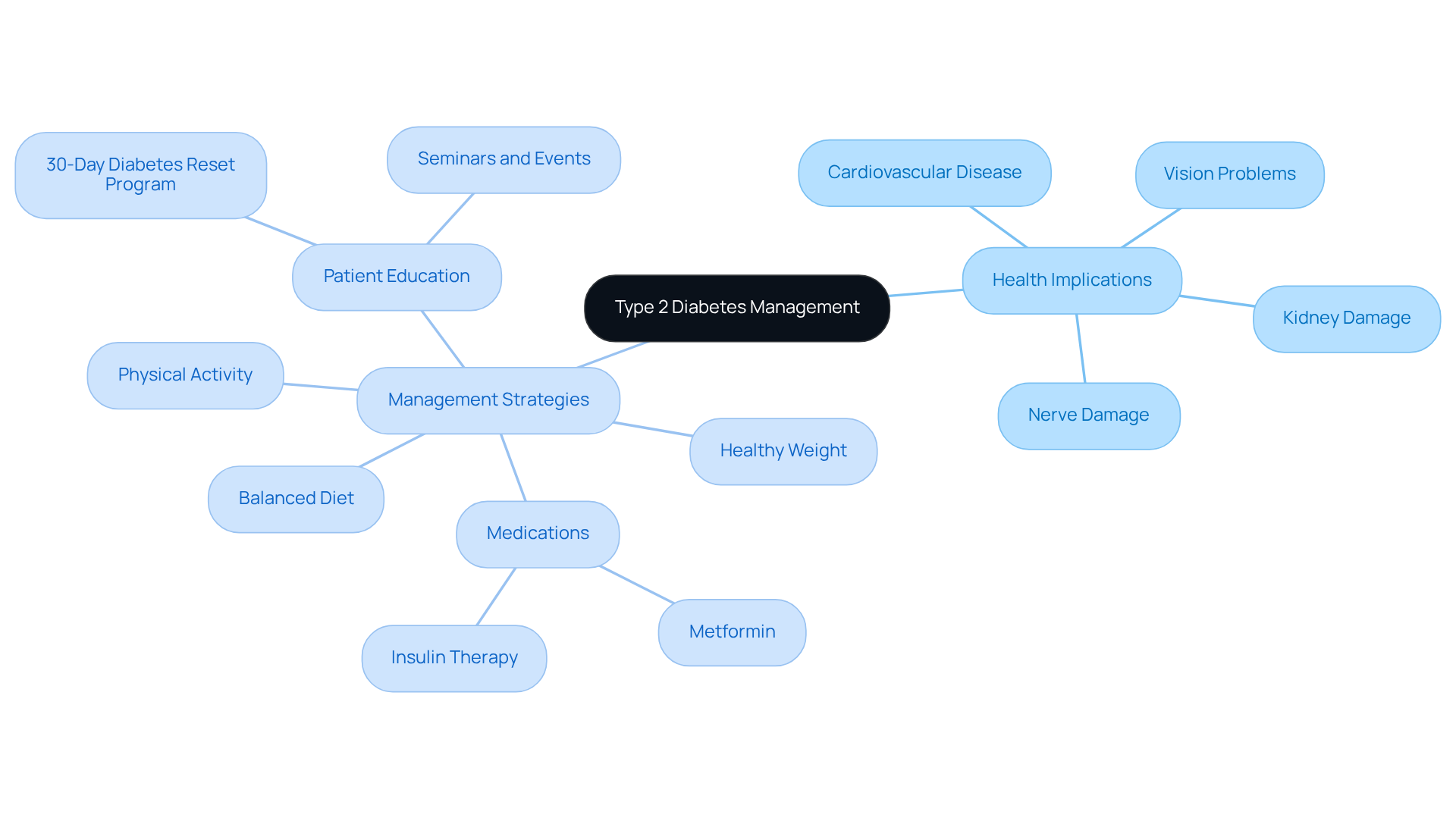Overview
Type 2 diabetes mellitus is more than just a chronic metabolic condition; it represents a significant challenge for many individuals, marked by ongoing high blood sugar levels due to insulin resistance and inadequate insulin production. This condition not only affects personal health but also has far-reaching implications for public health worldwide. It’s important to recognize that the prevalence of Type 2 diabetes is growing, and with it, the potential complications that can arise.
Many patients find that navigating this journey can be overwhelming. However, there is hope. Emphasizing the importance of lifestyle management and patient education can make a meaningful difference. By adopting a holistic approach, we can work together to improve patient outcomes. Imagine feeling empowered to take control of your health—this is where the 30-Day Diabetes Reset program comes in, offering you the support and guidance you need.
As we explore these ideas, remember that you are not alone in this struggle. Each step towards understanding and managing your condition is a step towards a healthier life. Let’s embrace this journey together, focusing on practical strategies and compassionate support that can lead to positive change.
Introduction
The rising prevalence of type 2 diabetes mellitus (T2DM) is a significant concern for public health, with projections estimating that nearly 783 million people will be affected by 2045. This metabolic disorder, characterized by insulin resistance and elevated blood sugar levels, not only impacts individual lives but also places a heavy burden on healthcare systems around the globe.
It’s important to recognize that understanding the complexities of T2DM—its definition, historical context, and management strategies—can empower individuals to take proactive steps towards better health.
Many patients find that with so many conflicting messages about treatment and lifestyle changes, it can be overwhelming to navigate the path to effective management and improved quality of life.
How can one find clarity amidst the confusion? Together, we can explore the journey toward healthier living.
Define Type 2 Diabetes Mellitus: An Overview
Type 2 diabetes mellitus definition refers to a long-lasting metabolic condition that can feel overwhelming. It is characterized by ongoing hyperglycemia, which arises from a combination of insulin resistance and insufficient insulin production from the pancreas. Unlike type 1 diabetes, where insulin production is absent, individuals with T2DM can produce insulin, but their bodies struggle to use it effectively. This condition often develops gradually and is closely linked to factors like obesity, sedentary lifestyles, and genetics.
It’s important to recognize that the World Health Organization (WHO) considers the type 2 diabetes mellitus definition to be a significant public health concern. The occurrence of this condition is expected to reach 783 million by 2045, highlighting a substantial rise in cases worldwide. In 2021, around 38.4 million adults in the U.S. were diagnosed with diabetes, and the type 2 diabetes mellitus definition represented over 90% of these cases. This condition is associated with severe complications, such as cardiovascular disease, kidney failure, and neuropathy, which underscores the urgent need for effective management and prevention strategies.
Many patients find that addressing lifestyle factors is crucial in tackling the increasing rates of obesity, a significant contributor to T2DM. At Integrative Wellness Center, Dr. Jason Shumard emphasizes the importance of providing individuals with actionable insights and practical tools. This nurturing approach fosters an environment where people can reclaim their wellness and well-being. Not only does this patient-centered method enhance quality of life, but it also reduces reliance on conventional medical interventions, aligning with holistic health solutions for managing the type 2 diabetes mellitus definition.
Are you ready to take the next step? Reach out to us today to discover how we can assist you in managing your condition effectively and safely. Consider the alarming statistics related to hospital safety, such as the 7,000 erroneous medications and 80,000 infections contracted by patients in healthcare facilities. Together, we can navigate this journey toward better health.
Trace the History and Evolution of Type 2 Diabetes
The history of this condition stretches back to ancient civilizations, with the term originating from the Greek word meaning ‘siphon,’ reflecting the frequent urination characteristic of the illness. It’s important to recognize that understanding this history can help us appreciate the journey of those affected.
It wasn’t until the 20th century that a clear distinction between class 1 and class 2 conditions emerged. The groundbreaking discovery of insulin in the 1920s marked a pivotal moment in treatment, revolutionizing care for individuals with form 1 of the illness. However, many patients find that it was not until the 1930s that form 2 of the disease was formally acknowledged as a separate condition.
Throughout the years, studies have highlighted the multifactorial aspects of the type 2 diabetes mellitus definition (T2DM), leading to various management approaches that emphasize lifestyle changes, medication, and education.
Dr. Jason Shumard’s holistic method to managing the condition includes tailored care and education, showcasing the progression of treatment. His 30-Day Diabetes Reset program employs methodologies such as functional nutrition and individual empowerment, transforming the lives of many individuals.
Testimonials reveal a remarkable shift from feeling depressed and fatigued to experiencing renewed energy and well-being. This showcases the potential for reversing type 2 conditions through a comprehensive, patient-centered approach.
Dr. Shumard’s postgraduate education in functional endocrinology and clinical nutrition further enhances the credibility of his methods, ensuring that individuals receive the highest standard of care.
If you’re feeling overwhelmed, remember that there is hope and support available to guide you on your journey toward better health.
Identify Key Characteristics and Diagnostic Criteria
Type 2 diabetes mellitus definition includes an overwhelming experience characterized by increased blood glucose levels and insulin resistance, often linked to metabolic syndrome. Many individuals experience frustrating symptoms such as excessive thirst, frequent urination, extreme fatigue, blurred vision, and slow-healing sores. It’s important to recognize that these signs can significantly impact daily life. According to the American Diabetes Association (ADA), the type 2 diabetes mellitus definition includes the following diagnostic criteria:
- A fasting plasma glucose level of 126 mg/dL (7.0 mmol/L) or higher
- A 2-hour plasma glucose level of 200 mg/dL (11.1 mmol/L) or higher during an oral glucose tolerance test
- An A1C level of 6.5% or higher
Early diagnosis is crucial; it can greatly improve management outcomes and reduce the risk of complications.
Many patients find that the occurrence of metabolic syndrome among individuals with this condition is significant. Common risk factors include obesity, hypertension, and dyslipidemia. Recent studies emphasize the connection between metabolic syndrome and type 2 diabetes, highlighting the importance of addressing these issues comprehensively. By tackling these challenges, we can improve patient wellness and well-being. Remember, you are not alone in this journey, and there are supportive resources available to help you navigate these changes toward a healthier lifestyle.
Examine the Health Implications and Management Strategies
Managing the type 2 diabetes mellitus definition can be a challenging journey, and it’s important to recognize that if not handled properly, it can lead to serious health issues. Conditions such as:
- cardiovascular disease
- kidney damage
- nerve damage
- vision problems
can arise. In fact, diabetes is a leading cause of newly diagnosed adult blindness and contributes significantly to kidney failure cases. But there is hope—effective management strategies emphasize lifestyle changes that can make a real difference.
Many patients find that adopting a balanced diet, engaging in regular physical activity, and maintaining a healthy weight are essential steps. Statistics suggest that these lifestyle changes can prevent or postpone the onset of the condition described in the type 2 diabetes mellitus definition and its complications. As the condition progresses, medications like metformin and insulin therapy may also become necessary to help manage blood sugar levels.
Patient education plays a crucial role in this process, empowering individuals to make informed choices about their health. Programs like Dr. Jason Shumard’s 30-Day Diabetes Reset provide valuable resources and support, equipping patients with the knowledge and tools needed to manage their diabetes effectively. This holistic approach not only addresses the symptoms but also targets the underlying causes of the condition, fostering long-term health improvements. Remember, you are not alone in this journey, and with the right support, you can take control of your health and well-being.
Conclusion
Type 2 diabetes mellitus represents a significant and growing challenge in public health, characterized by insulin resistance and elevated blood glucose levels. As the prevalence of this condition continues to rise, it’s important to recognize the urgency in understanding its definition, implications, and management strategies. This knowledge is essential for both individuals and healthcare providers. Alarming statistics indicate a projected increase in cases, underscoring the need for effective prevention and treatment methods.
Many patients find that grappling with type 2 diabetes can feel overwhelming. Throughout the article, we’ve shared key insights, including the historical evolution of type 2 diabetes, its diagnostic criteria, and the serious health implications associated with inadequate management. The multifactorial nature of the condition highlights the importance of lifestyle changes, patient education, and holistic approaches to care. Programs such as Dr. Jason Shumard’s 30-Day Diabetes Reset illustrate how personalized strategies can empower individuals to reclaim their health and mitigate the risks associated with type 2 diabetes.
Ultimately, the importance of addressing type 2 diabetes cannot be overstated. By fostering awareness, promoting healthy lifestyle choices, and providing support through targeted programs, it is possible to combat this escalating public health crisis. Embracing a proactive approach to managing diabetes not only enhances individual well-being but also contributes to a healthier society as a whole. Taking the next step toward better health is crucial, and resources are available to guide individuals on this journey. Remember, you are not alone in this; together, we can make a difference.
Frequently Asked Questions
What is Type 2 Diabetes Mellitus (T2DM)?
Type 2 Diabetes Mellitus is a long-lasting metabolic condition characterized by ongoing hyperglycemia due to insulin resistance and insufficient insulin production from the pancreas. Unlike type 1 diabetes, individuals with T2DM can produce insulin but struggle to use it effectively.
What factors contribute to the development of T2DM?
T2DM often develops gradually and is closely linked to factors such as obesity, sedentary lifestyles, and genetics.
How significant is the public health concern regarding T2DM?
The World Health Organization (WHO) considers T2DM a significant public health concern, with the number of cases expected to reach 783 million by 2045. In 2021, approximately 38.4 million adults in the U.S. were diagnosed with diabetes, with over 90% of these cases being T2DM.
What are the complications associated with T2DM?
T2DM is associated with severe complications, including cardiovascular disease, kidney failure, and neuropathy, highlighting the urgent need for effective management and prevention strategies.
How can lifestyle factors impact T2DM management?
Addressing lifestyle factors is crucial in tackling the increasing rates of obesity, a significant contributor to T2DM. Patients can benefit from actionable insights and practical tools to improve their wellness and reduce reliance on conventional medical interventions.
What approach does the Integrative Wellness Center take for managing T2DM?
At the Integrative Wellness Center, Dr. Jason Shumard emphasizes a patient-centered approach that provides individuals with actionable insights and practical tools, fostering an environment for reclaiming wellness and enhancing quality of life.
Why is it important to manage T2DM effectively?
Effective management of T2DM is essential to prevent severe complications and improve overall health, especially considering alarming statistics related to hospital safety, such as medication errors and infections contracted in healthcare facilities.



